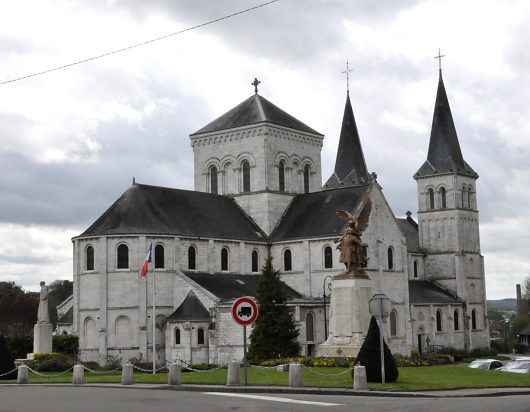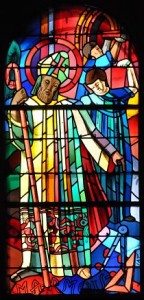L’église aujourd’hui en élévation date du XIXe siècle mais elle clôt une longue histoire de constructions et destructions. Une première mention apparaît en 1006 dans un acte affirmant son rattachement à l’abbaye de Fécamp. Les heurs et malheurs des édifices successifs ne sont guère connus et une église de style roman est construite en 1731. Incendiée en 1756, puis restaurée, elle traverse la Révolution en tant que dortoir, puis salle de réunion pour le Conseil Municipal. À la suite du Concordat, le culte catholique y est rétabli en 1802.
Au XIXe siècle, l’église, devenue trop petite, est démolie en 1853 et dés l’année suivante commence la construction d’une nouvelle église dans le style néo-roman et en s’inspirant de l’abbatiale Saint-Georges de Boscherville. Elle est inaugurée en 1855, mais réellement achevée en 1861.Elle abrite quelques statues contemporaines ainsi qu’une série de vitraux contemporains consacrés à saint Martin.
Les vitraux anciens de l’église Saint-martin de Barentin ont été frappés pour la plus grande part par l’onde choc d’un V1 en 1944; ils ont été remplacés en 1947 par les créations de François Lorin à Chartres, sur des cartons du peintre Georges Mirianon. La vie de Saint Martin s’y décline en plusieurs épisodes. ici Saint Martin devenu évêque de Tours, fonde le monastère de Marmoutier conformément à l’histoire racontée par Sulpice Sévère: » Pendant quelque temps, [Martin] logea dans une cellule attenante à l’église [de Tours]. Puis, ne pouvant plus supporter d’être dérangé par ceux qui venaient lui rendre visite, il s’installa un ermitage à deux milles environ hors les murs de la cité. Cette retraite était si écartée qu’elle n’avait rien à envier à la solitude du désert. D’un côté, en effet, elle était entourée par la falaise à pic d’un mont élevé et le reste du terrain était enfermé dans un léger méandre du fleuve de Loire ; il n’y avait qu’une seule voie d’accès, et encore fort étroite ».
Le vitrail très coloré comme toute la série de l’église de Barentin, présente un saint archevêque ( reconnaissable à son pallium) mais tenant sa crosse comme une crosse abbatiale tournée vers l’intérieur; il donne un ordre dirigé vers le compas et le triangle du bâtisseur. Derrière lui quelques ouvriers s’activent pour ériger le futur monastère. Le dynamisme de la création s’exprime dans l’attitude autoritaire et pleine d’allant du saint.
The church today dates from the 19th century, but it concludes a long history of construction and destruction. The first mention of it appears in 1006 in an act affirming its attachment to the abbey of Fécamp. The ups and downs of the successive buildings are hardly known and a Romanesque style church was built in 1731. It was burnt down in 1756, then restored, and lived through the Revolution as a dormitory, then as a meeting room for the Municipal Council. Following the Concordat, Catholic worship was re-established in 1802.
In the 19th century, the church, which had become too small, was demolished in 1853 and the following year construction began on a new church in the neo-Romanesque style, inspired by the abbey church of Saint-Georges de Boscherville. It was inaugurated in 1855, but actually completed in 1861, and houses some contemporary statues as well as a series of contemporary stained glass windows dedicated to Saint Martin.
The old stained glass windows of the church of Saint Martin in Barentin were mostly hit by the shock wave of a V1 in 1944; they were replaced in 1947 by the creations of François Lorin in Chartres, based on cartoons by the painter Georges Mirianon. The life of Saint Martin is presented in several episodes. Here Saint Martin, who became bishop of Tours, founded the monastery of Marmoutier, according to the story told by Sulpice Severus: « For some time, [Martin] lived in a cell adjoining the church [of Tours]. Then, unable to bear being disturbed by those who came to visit him, he set up a hermitage about two miles outside the city walls. This retreat was so remote that it had nothing to envy the solitude of the desert. On one side, in fact, it was surrounded by the sheer cliff of a high mountain and the rest of the land was enclosed in a slight meander of the Loire River; there was only one way of access, and it was still very narrow.
The very colourful stained glass window, like the whole series in the church at Barentin, shows a holy archbishop (recognisable by his pallium) but holding his crozier like an abbey crozier turned inwards; he is giving an order directed towards the compass and the builder’s triangle. Behind him, some workers are busy building the future monastery. The dynamism of creation is expressed in the authoritative and lively attitude of the saint.

 "/>
"/>
